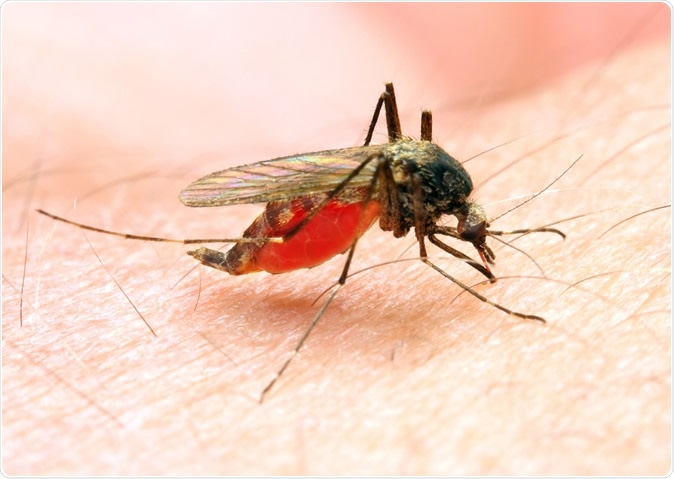The Ministry of Public Health in Madagascar has reported thousands of malaria cases over the past months. In March, more than 600 cases of malaria were reported weekly and at least 2,000 cases have been reported in less than a month. As a result, efforts to curb the outbreak were initiated.
The Madagascar National Strategic Plan for Malaria Control 2018 (NSP) shows malaria control pre-elimination strategies that involve detailed goals for mosquito control. The researchers aim to strengthen malaria prevention through mosquito surveillance. Hence, they conducted the study, which was published in PLOS Neglected Tropical Diseases, in remote villages in Madagascar.
Mosquito surveillance results
They found that female mosquitoes of the Anopheles species have more varied diets than previously known. The results can pave the way to better understand how the disease is transmitted to help formulate new malaria-prevention strategies.

Anopheles mosquito. Image Credit: Kletr / Shutterstock
The researchers used a modified barrier screen trap, dubbed as the Quadrant Enabled Screen Trap (QUEST), with a newly developed multiplex BLOOdmeal Detection Assay for Regional Transmission (BLOODART). During the study, the researchers captured 1,252 female Anopheles mosquitoes. All the mosquitoes underwent the BLOODART analysis.
The feeding pattern of the mosquitoes was analyzed and revealed multiple blood meal hosts. The most common mosquito host was a cow, then a pig, and humans. Subsequently, the researchers found that the tendency for mosquitoes to feed on humans increased between December 2017 and April 2018, from 27 percent to 44 percent. The finding suggests that host preferences of these mosquitoes vary from one season to another, hinting the need for surveillance and eradication efforts.
“The QUEST was an efficient tool for sampling exophilic Anopheline mosquitoes. Vectors considered to be of secondary importance were commonly found with Plasmodium DNA in their abdomens, indicating a need to account for these species in routine surveillance efforts,” the researchers concluded in the study.
“Mosquitoes exhibited multiple blood feeding behavior within a gonotrophic cycle, with predominantly non-human hosts in the bloodmeal. Taken together, this complex feeding behavior could enhance the role of multiple Anopheline species in malaria transmission, possibly tempered by zoophilic feeding tendencies,” they added.
The use of QUEST, the modified and outdoor-based net trap can be used in addition to already present mosquito control techniques.
"Outdoor trapping can pick up species that other sampling methods might miss out on," Dr. Riley Tedrow, a medical entomologist at Case Western Reserve University School of Medicine, said.
Tedrow also reiterated the importance of BLOODART, that combines an existing malaria test and mosquito species determination technique. This technique enables scientists to evaluate hundreds of mosquitoes, their food sources, presence of parasites of malaria, and species.
What is Malaria?
Malaria is a tropical disease that is caused by a parasite. Malaria parasites that commonly infect humans include Plasmodium falciparum, Plasmodium vivax, Plasmodium ovale, and Plasmodium malariae. However, Plasmodium falciparum is the malaria type that may result in severe infection and if it’s left untreated, may lead to death.

Plasmodium falciparum 3d illustration - Credit: Sciencepics / Shutterstock
The infection is a life-threatening disease and the parasites are transmitted to people through the bites of infected female Anopheles mosquitoes. Though it can be life-threatening, it’s curable and preventable.
In 2017 alone, there were about 219 million cases of malaria in 87 countries. About 445,000 people have died of malaria, most are children in Africa. In the United States, about 1,700 cases of malaria are diagnosed every year. Most of these cases are travelers or immigrants coming back from countries with malaria cases, such as South Asia and sub-Saharan Africa.
The signs and symptoms of malaria include a flu-like illness, with muscle pain, headache, chills, and fatigue. Other symptoms may emerge such as vomiting, nausea, and diarrhea. Some complications may manifest, such as jaundice and anemia, due to red blood cells loss. In severe cases and if the disease is not treated promptly, it may lead to seizures, kidney failure, mental confusion, coma, and even death.
Source:
Journal reference:
Anopheles mosquito surveillance in Madagascar reveals multiple blood feeding behavior and Plasmodium infection, Riley E. Tedrow, Tovonahary Rakotomanga, Thiery Nepomichene, Rosalind E. Howes, Jocelyn Ratovonjato, Arséne C. Ratsimbasoa, Gavin J. Svenson, Peter A. Zimmerman
Published: July 5, 2019, https://doi.org/10.1371/journal.pntd.0007176, https://journals.plos.org/plosntds/article?id=10.1371/journal.pntd.0007176